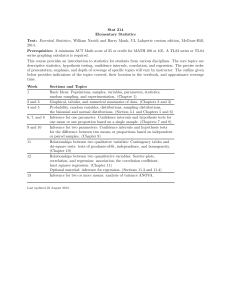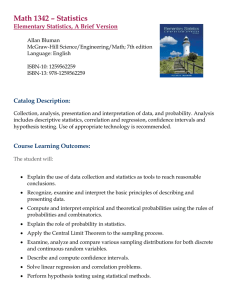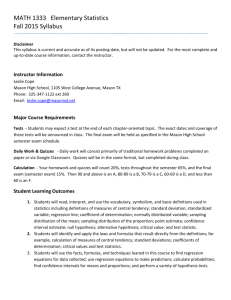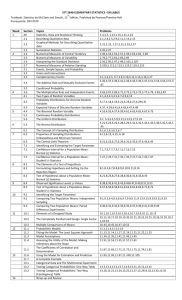Elementary Statistics/MTH 167
advertisement
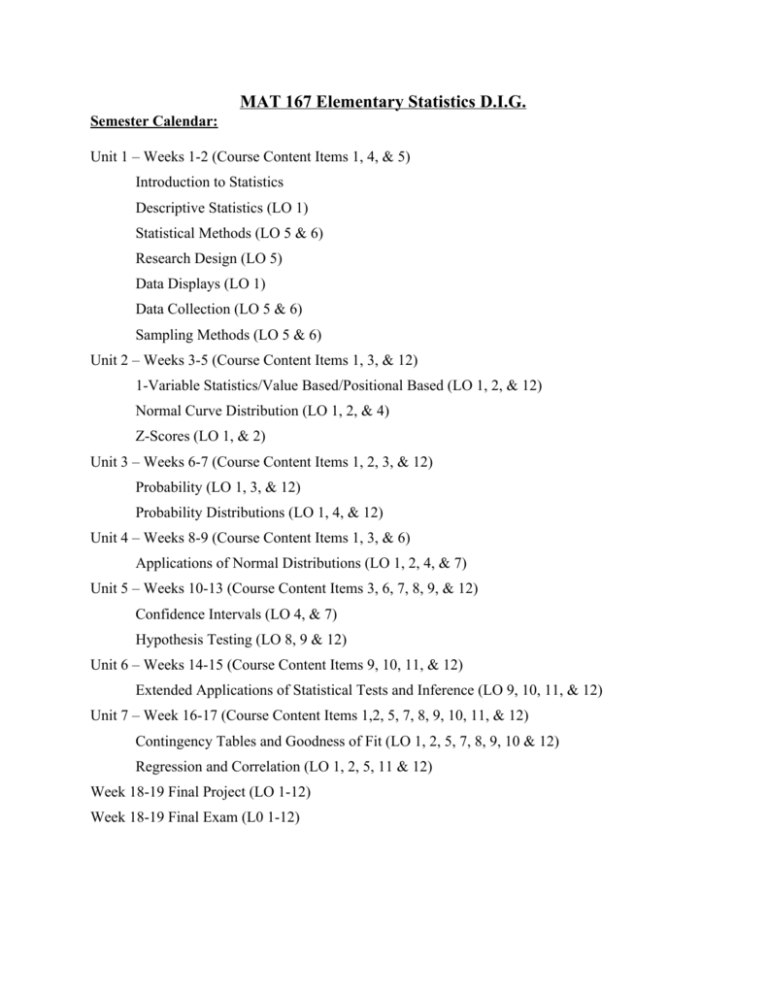
MAT 167 Elementary Statistics D.I.G. Semester Calendar: Unit 1 – Weeks 1­2 (Course Content Items 1, 4, & 5) Introduction to Statistics Descriptive Statistics (LO 1) Statistical Methods (LO 5 & 6) Research Design (LO 5) Data Displays (LO 1) Data Collection (LO 5 & 6) Sampling Methods (LO 5 & 6) Unit 2 – Weeks 3­5 (Course Content Items 1, 3, & 12) 1­Variable Statistics/Value Based/Positional Based (LO 1, 2, & 12) Normal Curve Distribution (LO 1, 2, & 4) Z­Scores (LO 1, & 2) Unit 3 – Weeks 6­7 (Course Content Items 1, 2, 3, & 12) Probability (LO 1, 3, & 12) Probability Distributions (LO 1, 4, & 12) Unit 4 – Weeks 8­9 (Course Content Items 1, 3, & 6) Applications of Normal Distributions (LO 1, 2, 4, & 7) Unit 5 – Weeks 10­13 (Course Content Items 3, 6, 7, 8, 9, & 12) Confidence Intervals (LO 4, & 7) Hypothesis Testing (LO 8, 9 & 12) Unit 6 – Weeks 14­15 (Course Content Items 9, 10, 11, & 12) Extended Applications of Statistical Tests and Inference (LO 9, 10, 11, & 12) Unit 7 – Week 16­17 (Course Content Items 1,2, 5, 7, 8, 9, 10, 11, & 12) Contingency Tables and Goodness of Fit (LO 1, 2, 5, 7, 8, 9, 10 & 12) Regression and Correlation (LO 1, 2, 5, 11 & 12) Week 18­19 Final Project (LO 1­12) Week 18­19 Final Exam (L0 1­12) Course Description: MAT 167 Elementary Statistics. Credit Hours: (3) Statistical tools and techniques used in research and general applications. Description of sample data, probability and probability distributions, point and interval estimates of population parameters, hypothesis testing, and correlation and regression. Course Content: 1. Descriptive Statistics 2. Probability 3. Normal Distribution 4. Research Design 5. Sampling Strategies 6. Confidence Intervals 7. Hypothesis testing of one population 8. Hypothesis testing of two populations 9. Tests of categorical data 10. Regression and Correlation 11. Statistics Technology Learning Outcomes: 1. Use both numerical and graphical methods to describe data. (1) 2. Compute and interpret measures of central tendency and variability. (1) 3. Compute probabilities for both simple and compound events.(2) 4. Apply the normal distribution to probability problems and estimation of population parameters. (3) 5. Critique the research methods of others, and use research methodology. (4,5) 6. Produce representative random samples. (5) 7. Calculate and interpret confidence intervals as estimates of population parameters. (6) 8. Perform hypothesis tests about means and other parameters from large and small samples using one and multiple sample methods. (7,8) 9. Test hypothesis about categorical data. (9) 10. Recognize appropriate use of non­parametric vs. parametric statistical tests. (10) 11. Use regression and correlation to test hypothesis and create models for bivariate data. (11) 12. Use both hand­held calculators and desktop computers to perform statistical analysis. (12)

